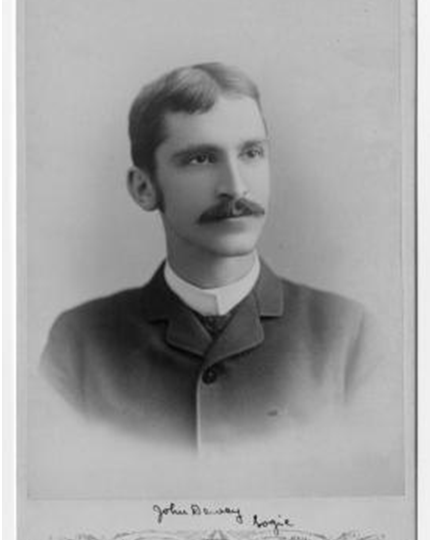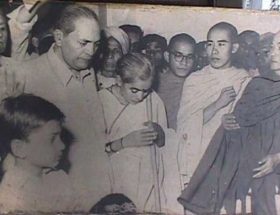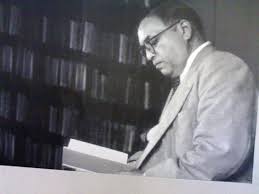Scott R. Stroud
The relationship between Bhimrao Ambedkar, anti-caste thinker and activist, and John Dewey, his teacher at Columbia University, is significant and unique. Ambedkar sat in three of Dewey’s courses while he was studying at Columbia University and kept up with the American thinker’s philosophical evolution over the following four decades largely through collecting Dewey’s books. At least twenty-two books by or about Dewey remain in the archival collections of Ambedkar’s personal library. But there’s much more to this story yet to be unearthed. As I explore in The Evolution of Pragmatism in India, this intellectual relationship cannot be ignored in making sense of Ambedkar’s genius and passion in pursuing social democracy in India. One of the most common questions I get asked, both in India and in the U.S., when I discuss the Dewey-Ambedkar relationship is this— what about the Dewey side of the Ambedkar-Dewey relationship?
While there’s no mention of Ambedkar in his teacher John Dewey’s works or correspondence, and Ambedkar apparently never tried to write to Dewey, we can still wonder: What did Dewey think about Indian philosophy? In recent posts elsewhere, I’ve explored Dewey’s (and Ambedkar’s) common approaches to “caste” as well as Deweyalmost travelling to India during his stay in China. Full details on these aspects tothe Dewey-Ambedkar relationship can be found in this article in The Pluralist. In this post, I will explore the interesting relationship John Dewey had with intercultural or comparative philosophy in general, and Indian philosophy in particular. This is important because it shows what the context for his engagement—or lack thereof—with his student Bhimrao Ambedkar. It also will serve as a warning to contemporary western pragmatist philosophers to ignore Ambedkar’s creative philosophy at their own peril.

What was Dewey’s view on Indian philosophy? This is a difficult question to answer primarily because his views changed over time, both toward Indian philosophy and non-western philosophy in general. Let us start with young Dewey, bright eyed and bearing a big mustache. During his early years in the 1890, Dewey chose to both use terms from Indian tradition such as “caste” and to review books about Indian thought. In 1895, shortly after he had moved from Michigan to Chicago, Dewey published reviews of important early translations of classical Indian philosophical works—Paul Deussen’s The Elements of Metaphysics and F. Max Müller’s Three Lectures on the Vedanta Philosophy.
These works are important because they represent an attempt by European orientalists to render Indian thought palatable to western readers perhaps intrigued by their “exotic” pedigree. Dewey would have none of that fascination. His reviews were largely dismissive, noting that these works dealt with “an old philosophy of India”—Advaita Vedanta, basically. He attributes their popularity not to their inherent philosophical worth, but to their aura of “occultism and Orientalism in one form or another” that built on “traits of the existing popular consciousness.” Dewey’s early review of Deussen’s book revealed his dismissive attitude. “The translation is well done; but was the original worth translating?” Dewey asked. He then quickly answered this query for his readers: “The form is largely a quasi-geometrical method; definitions abound, which, like all philosophic definitions that precede, instead of summing up discussion, beg the question; disjunctions, which ingeniously conceal the problem while appearing to simplify it, are numerous. And through it all is the gospel of the Vedanta, with Schopenhauer as its prophet and expounder.”
WasDuessen’sbook worth reading? Dewey’s judgment was largely negative in 1895: “Those who already know their Spinoza and Kant and Schopenhauer will hardly get much out of the book; those who want a philosophy not for philosophic but for aesthetic and emotional purposes may easily turn from, say, theosophy to Dr. Deussen’s constructions of the universe.” Müller’s book did not fare much better, receiving positive praise largely for its characteristic of being an organized presentation of these familiar ideas that could be found in Spinoza and other western thinkers. According to Dewey’s take in the 1890s, Indian thought didn’t have much to add to philosophical inquiry in the west.
Dewey’s brashness—and dismissiveness—would fade over the following decades, allowing for a slow warming to Indian thought. Part of the cause for this surely was his exposure to various strands of Asian thought during his extended tour of Japan and China between 1919 and 1921. Dewey almost tacked on a visit to India during this trip, but homesickness, growing expenses, and his own limited imagination about what India might offer led him to postpone this visit to a time that would never come. China did offer an extended exposure to a deep-rooted tradition and its evolving effects in crowded settings of a restless China, which many have said affected his moral and political philosophy’s changes in the late 1920s and early 1930s.
As Dewey began to appreciate China’s contribution to philosophy more, he also began to warm to India’s resources, albeit more slowly. By 1931, we see Dewey adopting a new openness to Indian philosophy by penning a warm introduction for Jagadish Chandra Chatterji’s book,India’s Outlook on Life: The Wisdom of the Vedas (1931). Chatterji had previously authored books on Hindu realism and Nyaya logic (1912) and Kashmiri Shaivism (1914). In his short introduction to Chatterji’s book on Indian thought stemming from the vedic tradition, Dewey espoused a humble openness to Indian thought: “It would be difficult to find one less fitted by previous study and knowledge to write an introduction to an account of Vedic philosophy than the present writer.”

Dewey’s 1931 Introduction
In the course of the introduction, Dewey acknowledged that his lack of knowledge was a problem, and that intercultural or global philosophy was something that he (and others) ought to attend to more: “with the increasing intellectual contact of the East and West, it is obviously of importance that we of the Western world should have authentic information regarding the culture of India.” Dewey also saw the challenges in comparative approaches to philosophical problems, since “it is not easy to translate from one system into the other.” But his tone was not dismissive of the potentials of Indian thought as it was in 1895; quite the opposite, he seemed intrigued by the promises and perils of intercultural exchange. Dewey even supported a public appeal with Jane Addams and others to get Gandhi to visit America during the 1930s.

Appeal to Gandhi in the New York Times
There’s evidence that Dewey possessed—and perhaps read—a copy of Edwin Arnold’s famous translation of the Bhagavad Gita. In the remains of Dewey’s library, there is an edition of Arnold’s The Song Celestial or Bhagavad-Gita (1930). As noted inside its cover, the book was given to him in July 1934 by “Fred W. Bell of Johannesburg,” in all likelihood Frederick William Bell (1875-1954). Bell was an Australian who fought in the Boer War in South Africa between 1899-1900. He apparently was very interested in the philosophy of the Gita, since he had hand-numbered all of the verses in the copy he gifted to Dewey and penned a range of appendixes at the end on key concepts such as “nirvana,” “gunas,” and “self.” Dewey may have very well read this hand-curated copy of the Gita after Bell took the time to prepare it and send it to him.

Dewey’s copy of the Bhagavad Gita, annotated by Bell
As I discuss in my article in The Pluralist, there’s even evidence that Dewey was reading the English-language Gita Rahasya of Bal Gangadhar Tilak (1856-1920) at the end of his life in his Nova Scotia cabin in the 1950s. This enormous commentary on the Gita, as well as its forceful author, was frequently on the mind of Ambedkar given Tilak’s commitment to a caste-fortifying reading of karma yoga in the Gita. In Ambedkar’s personal copy of the Gita Rahasya (preserved in Siddharth College’s archives), we see perhaps the most personality revealed by Ambedkar the reader. In the margins, one can see his annotations (written in his familiar red and blue pencil marks) that convey the seriousness with which he engaged this text—as well as his critical demeanor, since even wrote missives like “False” next to text that he disagreed with. Tilak was a useful goad to Ambedkar’s counter-thought to the Gita, and perhaps he also inspired Dewey in some (as of now) unknown manner.

Ambedkar’s Annotations on Tilak’s Gita Rahasya
In Dewey’s final full decade, he became more and more open to intercultural philosophy. He watched as comparative philosophy started to bloom in the field, largely driven by the efforts of Wing-tsit Chan and Charles Moore, and the East-West Philosophers’ Conference orbiting the University of Hawai’i. With Mary Kingsbury Simkhovitch and a few others, Dewey co-authored a public letter to India’s first prime minister, Jawaharlal Nehru, during the Indian statesman’s visit to the U.S. (which included a short appearance at Dewey’s large public birthday celebration). The letter praised Nehru for “a drastic reconsideration of the methods by which we can attain that world community of freedom, understanding and cooperation longed for by the masses of mankind.”

A Draft of the Public Letter to Nehru
Dewey seemed genuinely interested in India’s role in the world, and the philosophical resources that grounded this importance. But time was growing short. Dewey was confronted with increasingly frail health and decreased energy for his philosophical projects. Dewey remained as active as he could, even authoring large works such as Knowing and the Known (1949) with Arthur Bentley—a work that we know that his now-aged student, Ambedkar, knew about, given the evidence of his own notetaking from the 1950s.

A notecard created by Ambedkar in the 1950s.
But Dewey’s time was growing short.Charles Moore, the editor of the new comparative philosophy journal, Philosophy East and West, convinced Dewey to contribute a piece to its inaugural issue in 1951. Leading the first issue off was Dewey, followed by pieces authored by Sarvepalli Radhakrishnan and George Santayana, all on the topic of “philosophical synthesis.” What Dewey’s piece lacked in extended analysis, it made up for with its openness to global philosophy. The short piece struck an admirable tone for the new journal’s philosophical mission. Dewey indicated that taking cultural traditions as “blocks” of already set, and opposed, meanings was a mistake, and that they themselves were places of synthesis or “complex meeting points or webs of relationships.”

Contents from Volume 1, Issue 1 of Philosophy East and West
Philosophy was always synthetic, and in a global world, that synthesis should be mindfully extended to the meetings of various cultures with all their resources and richness. The dismissiveness of the 1890s evinced by young Dewey had changed into an intrigued reticence of the 1930s; by 1950, he was ready to learn from the complex and often contradictory traditions of China, India, and other cultures.
But Dewey would die only a year later in 1952, and he did not apparently have the time or inclination to follow through on this new charge in the time preceding his demise. There’s no evidence that I can find that he reached out to Ambedkar in his final years in life, or read the Indian thinker’s own works (I survey the claims about Dewey having read “Annihilation of Caste” here and find them very dubious). I have found no evidence that Ambedkar attempted to meet or correspond with Dewey either.He probably did not know what Ambedkar had been up too all of those years after they parted ways in 1916; if Dewey was like many modern observers of Ambedkar’s legacy, he may have mistakenly seen Ambedkar as only a politician or civil rights advocate.
Of course, Ambedkar was also and always a thinker, a philosopher. What might Dewey have learned from conversing with him on caste and democratic theory, or religion as a way of life as seen through Ambedkar’s revised Buddhist framework? The tragedy of Dewey’s engagement with India (and Ambedkar) is that he began to see the promise in synthetic or global philosophical projects just as his time and energy ran out. If only Dewey had this epiphany of the promise of intercultural philosophy when he was in the same room as Hu Shih and Bhimrao Ambedkar in his Philosophy 131-132 course sequence at Columbia University!
But his timing was off, and in life, timing is everything. In 1952, Ambedkar wrote to his wife, Savita, upon hearing of Dewey’s death that “I owe all my intellectual life to him.” We’re still figuring out what Ambedkar meant by those words, given his creative and new philosophy. Butthis much is also certain. Those of us travelling in Dewey’s wake now assume agreater debt to Ambedkar. We must acknowledge Dewey’s own blind spots and missed opportunities, and we ought to explore the ways that pragmatism can be critiqued and changed in an engagement with Indian traditions of thought, the foremost being the complex philosophy of Dewey’s creative student, Ambedkar. If Dewey’s philosophy emphasized flexibility and adaptiveness in our ever-changing social and natural environments, it is treason to the spirit animating his philosophy to turn our backs to what Ambedkar’s example—and own philosophy—can teach us about the potentials and limitations in Dewey’s own pragmatism. Being open to such synthetic endeavors can teach us more about Dewey’s thought—and about the novel philosophy of Ambedkar.
~~~
Scott R. Stroud is a professor of communication studies in the Moody College of Communication at the University of Texas at Austin. He is the author of The Evolution of Pragmatism in India (HarperCollins India / University of Chicago Press, 2023) and co-founder of the first “Center for John Dewey Studies” in India at Savitribai Phule Pune University. He also serves as the Program Director of Media Ethics at the Center for Media Engagement










